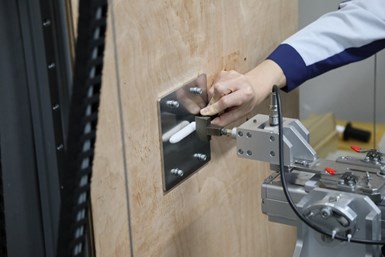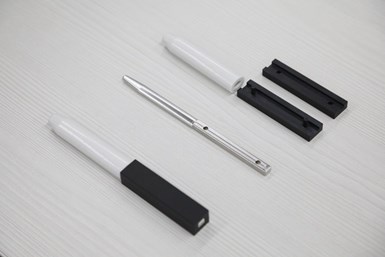Panasonic, Toyota Design Safety Device for Human-Robot Interaction
Operators can assess the risk of potential injuries by inserting the finger-like device in and around the parts of the robots or machinery most likely to come into contact with humans.
Share




In 2018, Panasonic partnered with Toyota to develop solutions that would make human interaction with robots safer in the workplace. Panasonic contributed its proprietary human-safety evaluation technology, while Toyota shared its extensive knowledge and experience in automated manufacturing.
Panasonic incorporated Toyota’s requirements into the design of an initial prototype product that would assess and visualize the risks of potential injuries resulting from human-machine collaboration. The design specs were provided to Tanac, a Japanese firm active in the development of new materials and technologies for use in the field of medical treatments and healthcare. Tanac manufactured the resulting product.
The device consists of a core rod portion that corresponds to the human finger bone enclosed in a soft proprietary silicon-based material designed to replicate the properties of human flesh. By inserting and moving the dummy in and around the parts of the robots or machinery most likely to come into contact with humans, operators can assess the risk of potential injuries.
Panasonic says the newly-launched device is already attracting the attention of leading manufacturers, as people and robots come into increasing contact at workplaces around the world.
Related Content
-
How to Pass the Job Interview as an Employer
Job interviews are a two-way street. Follow these tips to make a good impression on your potential future workforce.
-
How I Made It: Amy Skrzypczak, CNC Machinist, Westminster Tool
At just 28 years old, Amy Skrzypczak is already logging her ninth year as a CNC machinist. While during high school Skrzypczak may not have guessed that she’d soon be running an electrical discharge machining (EDM) department, after attending her local community college she found a home among the “misfits” at Westminster Tool. Today, she oversees the company’s wire EDM operations and feels grateful to have avoided more well-worn career paths.
-
Inside Machineosaurus: Unique Job Shop with Dinosaur-Named CNC Machines, Four-Day Workweek & High-Precision Machining
Take a tour of Machineosaurus, a Massachusetts machine shop where every CNC machine is named after a dinosaur!
























